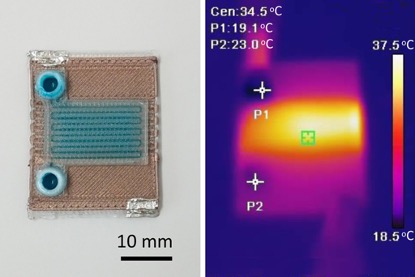Self-Heating Microfluidic Devices Can Detect Diseases in Tiny Blood or Fluid Samples
December 19, 2023
Source: drugdu
 224
224

Microfluidics, which are miniature devices that control the flow of liquids and facilitate chemical reactions, play a key role in disease detection from small samples of blood or other fluids. Commonly known examples include at-home Covid-19 test kits, which use basic microfluidic technology. However, more complex microfluidic applications often require chemical reactions at precise temperatures. Typically, these advanced devices are produced in clean rooms and include heating elements made of expensive materials like gold or platinum, making the manufacturing process costly and challenging to scale. Researchers have now made a breakthrough by employing 3D printing to build self-heating microfluidic devices, potentially paving the way for the creation of affordable and efficient tools that could detect various diseases.
Scientists at the Massachusetts Institute of Technology (MIT, Cambridge, MA, USA) innovatively utilized multimaterial 3D printing to fabricate microfluidic devices with integrated heating elements. This development allows for precise temperature control of fluids moving through the device's microscopic channels. The method is highly customizable, enabling engineers to design microfluidics that heat fluids to specific temperatures or follow defined heating patterns in designated areas of the device. Remarkably, this cost-effective production method requires only about USD 2 worth of materials for each fully functional microfluidic device.
The dimensions of the device are comparable to a U.S. quarter, and its production is quick, taking only a few minutes. This advancement is particularly significant for remote or under-resourced areas in developing countries, where access to expensive laboratory equipment for diagnostic tests is often limited. Looking ahead, the researchers aim to incorporate magnets directly into the microfluidic devices. These embedded magnets could facilitate chemical reactions that require the sorting or aligning of particles. The researchers are also investigating alternative materials capable of achieving higher temperatures. This innovation in microfluidic technology represents a significant step towards more accessible and efficient diagnostic tools, especially in areas with limited resources.
“Clean rooms in particular, where you would usually make these devices, are incredibly expensive to build and to run,” said Luis Fernando Velásquez-García, a principal scientist in MIT’s Microsystems Technology Laboratories (MTL). “But we can make very capable self-heating microfluidic devices using additive manufacturing, and they can be made a lot faster and cheaper than with these traditional methods. This is really a way to democratize this technology.”
Source:
https://www.labmedica.com/technology/articles/294799594/self-heating-microfluidic-devices-can-detect-diseases-in-tiny-blood-or-fluid-samples.html
Read more on
- Multiple batches of quadrivalent influenza virus split vaccine have been sub-packaged and submitted for lot release approval; expected to be released to the market soon after approval December 12, 2025
- Ab&B Bio-Tech CO., LTD. JS Lyophilized Human Rabies Vaccine Initiates Phase III Clinical Trials December 12, 2025
- The ‘Sweetest’ HPV Vaccine Market is Gone | Haibin Interview December 12, 2025
- InnoCare Pharma announced that its first independently developed next-generation TRK inhibitor, zoletrazinib, has been approved for marketing in China December 12, 2025
- Is PD-1/VEGF dual antibody + ADC becoming the standard configuration? December 12, 2025
your submission has already been received.
OK
Subscribe
Please enter a valid Email address!
Submit
The most relevant industry news & insight will be sent to you every two weeks.



